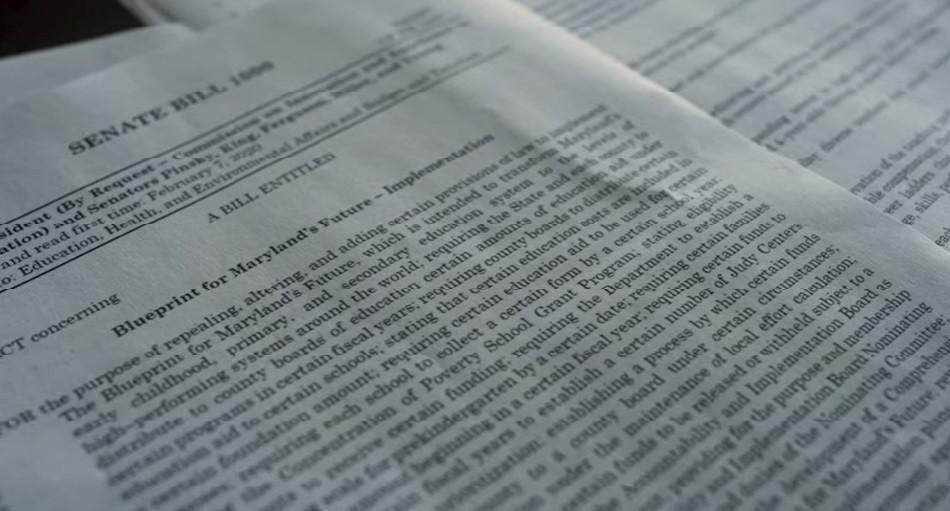It’s finally released.
The Blueprint for Maryland Future’s Accountability and Implementation Board has released a nearly 180-page draft document that outlines plans to revamp the state’s education system.
The proposed 10-year comprehensive plan details a multi-billion-dollar plan to reform early childhood education, hire and retain high-quality and diverse teachers, ensure students are prepared for college and technical careers and provide additional resources for students in need.
When the board hosts two virtual public hearings next week, the document slated for final approval by Dec. 1 could be trimmed or changed.
Four advisory committees will continue to convene throughout the month to offer recommendations on whether to delete, restructure, or improve certain proposed policies.
“We’ll never arrive at the perfect recipe. I just think it’s supposed to push us off the status quo,” said David Harper, vice president for workforce and academic programs at Chesapeake College in Talbot County.
Harper serves as vice chair on a committee that met virtually Wednesday to review a section on college and career readiness.
One of the goals would be to assess whether students are geared toward higher education or receive technical training skills that lead to “industry-recognized credentials and high-paying jobs.” The state Department of Education would establish a college and career readiness standard to assess where students are academically by the 10th grade.
The state must also develop a communications strategy to inform students, parents and educators in all 24 school systems about various benchmarks.
“The same collaboration that’s happening at the state level has to happen at every level,” said Olivia Pearson, who chairs the college and career committee and works as a college readiness supervisor for Prince George’s County public schools. “It’s got to be collaboration and coordination amongst all stakeholders.”
A second committee also met online Wednesday to review early childhood education policies.
The main goals of those reforms include expansion of access for 3- and 4-year-old children in prekindergarten; addressing transportation needs for the state’s youngest students; and helping parents choose where to send their children for care based on financial or educational needs.
The committee discussed a proposal that would require prekindergarten teachers to either have state certification in early childhood education or a bachelor’s degree “in any field” while pursuing alternative certification. This would be implemented in the 2025-26 school year.
Gina Hoover, an early learning lead teacher for Washington County public schools, said the timeframe would work for educators in the public schools but it would be harder for private providers to find certified teachers.
Ruby Daniels, president of the Maryland State Family Child Care Association, agreed.
“I don’t think we can afford a certified teacher because they make more than what we take home,” said Daniels, who co-chairs early childhood committee.
She expressed concern about how the state would require private providers fill at least 30% of their prekindergarten roster spots during this fiscal year and phase up to 50% in the next four years. She noted that the success of Blueprint reforms depend on having a “true mixed-delivery system,” which both public schools and private care providers serving young students.
“If we lose our 3- and 4-year-olds, I don’t think we can survive. More and more child care programs will close,” Daniels said.
Declining scores
As state school officials continue work on the Blueprint program, a report released last week by the National Assessment of Education Progress showed a nationwide decline in tests scores in mathematics and reading.
Known as the “Nation’s Report Card,” it showed Maryland’s fourth- and eighth-grade students fared no better.
Approximately 69% of fourth graders performed at or below the basic level and eight graders stood at 75%.
In terms of reading, fourth graders performed at 69% at or below the basic level. Eighth graders were recorded at 67%.
State superintendent Mohammed Choudhury said in a statement Oct. 24 that Maryland has experienced a downward trend since 2013.
A return to normal is not good enough,” he said. “The current struggles of our students cannot be solely attributed to the pandemic. Our goal is to ensure that every Maryland student has access to excellent educational opportunities to realize their full potential, especially those who have been historically underserved.”
By William J. Ford



Reed Fawell 3 says
I am looking forward to reading this, potentially on of most important documents we will read. Let’s see if there is truth in that hope.